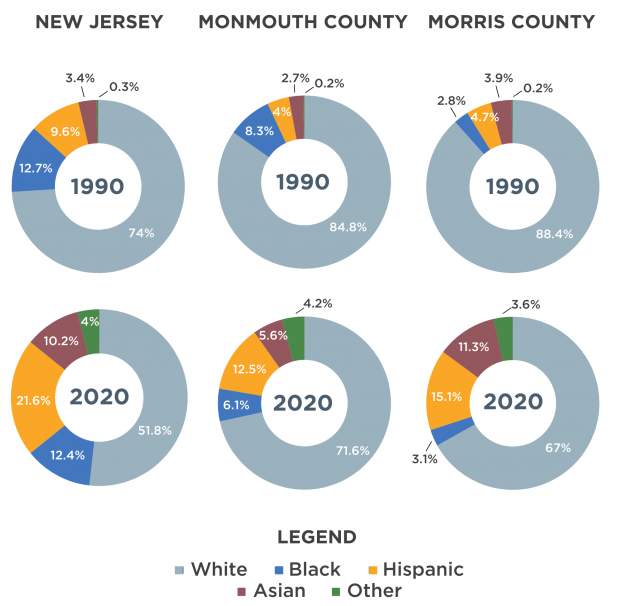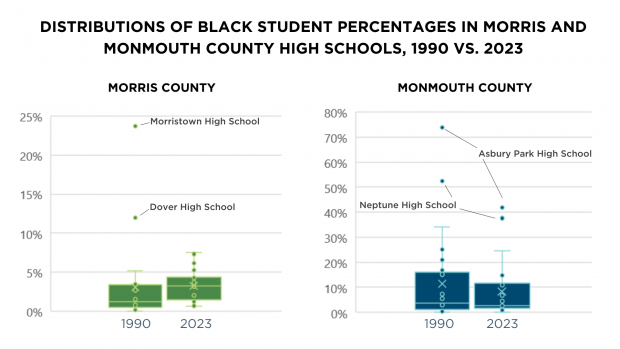New Jersey Future Blog
New Report Digs Deeper into Diversity in Morris and Monmouth Counties
January 29th, 2024 by Tim Evans
New Jersey is an expensive state, with among the highest housing costs in the country. It is also one of the most segregated states in the nation by both income and race, despite being one of the most racially diverse states overall. A new report from New Jersey Future explores the relationship between the enforcement of housing requirements, housing affordability, and racial and economic diversity, using a comparison between two demographically similar suburban counties—Morris and Monmouth—that followed different trajectories in complying with New Jersey’s affordable housing obligations. The findings of our analysis are included in “Breaking Barriers: A Comparative Analysis of Affordable Housing Compliance and Diversity in Morris and Monmouth Counties, New Jersey.”
Morris County municipalities had a head start in meeting affordable housing obligations. Our new report compares their progress to their counterparts in Monmouth County to chart New Jersey’s progress in promoting integration through affordable housing.
The New Jersey Supreme Court’s Mount Laurel decisions in the 1970s and 80s took on the issue of racial segregation by addressing the lack of housing options, eventually leading to a legal requirement for every municipality in the state to provide its fair share of the regional housing need for low- and moderate-income households. But the bureaucratic process set up in the wake of the court decisions, overseen by the Council on Affordable Housing (COAH), featured numerous loopholes via which municipalities could shirk their responsibilities to produce actual housing units. Monmouth County’s municipalities have been governed entirely by the Mount Laurel process, while a group of Morris County municipalities were the subject of a separate lawsuit, initiated in 1978, that predated the second Mount Laurel decision, giving Morris County a head start in compliance with affordable housing obligations.
Housing costs and racial segregation go hand in hand. Many towns use their zoning power to limit the variety of housing options available, allowing primarily single-family detached homes on large lots. The resulting lack of lower-cost housing options renders many places off-limits to households of modest means, particularly Black and Hispanic households, whose incomes tend to be much lower than those for other racial subgroups. Whether motivated solely by fiscal concerns or by race- and class-based prejudices, large-lot zoning often results in segregation by both income and race.
The report considers whether Morris County’s having been the subject of an earlier, separate lawsuit appears to have resulted in the county producing more affordable housing, or achieving greater reductions in racial and economic segregation, compared to Monmouth County. Analysis suggests that the lawsuit was effective; the municipalities of Morris County have outperformed those of Monmouth County in the subsequent decades, in terms of producing new affordable housing. Morris County’s increase in affordable housing was more broad-based than in Monmouth County, happening across all municipalities and not just mainly in the handful of places that had already been providing a disproportionate share of the county’s supply before the COAH process was instituted.
While both counties today remain whiter and wealthier than the state as a whole, Morris County increased in racial diversity and narrowed its gap with the statewide racial distribution at a faster rate than Monmouth County did between 1990 and 2020. This is particularly true with the counties’ Black populations; the Black population share increased in Morris County as a whole and in a majority of its individual municipalities (30 out of 39), while in Monmouth, the Black percentage dropped countywide and in 30 out of 53 municipalities.

While Morris County and Monmouth County both remain whiter than the state overall, Morris has closed its diversity gap with the state faster than Monmouth has.
Morris County’s better progress toward reducing racial segregation at the local level is visible in the demographics of the two counties’ high schools, where changes in the Black and Hispanic student populations tended to mirror changes in the demographics of the general population. Morris County high schools generally saw their Black student percentages increase slightly, whereas in Monmouth County, more than half of high schools saw their Black student percentages decline. Hispanic student populations grew across the board in both counties, with the median Hispanic percentage being almost identical in the two counties’ high schools in 2023, though Morris County started from a lower baseline, in relative terms, in 1990. Progress was much less pronounced in both counties regarding income diversity, however, suggesting that the Mount Laurel process alone is simply insufficient to address the housing needs of households throughout the lower and middle parts of the income distribution.

Morris County high schools generally saw their Black student percentages increase slightly, whereas in Monmouth County, the median Black student percentage among the county’s high schools actually declined.
The data examined in this report suggest that targeted enforcement of municipal requirements to produce more affordable housing actually results in more affordable housing. When presented with loopholes like those embedded in the COAH process that allow participants to evade their responsibility to provide housing options for lower-income households, many municipalities will avail themselves of the opportunity. But under more specific accountability, as illustrated by the Morris County lawsuit, towns can indeed be induced to produce a greater variety of housing options, thereby making themselves more affordable to a broader range of households and helping dismantle racial and economic barriers.
The report makes several recommendations for advancing the creation of more affordable housing, and more generally for mitigating local resistance to creating a greater diversity of housing types. Two of the recommendations are of particular interest in light of new legislation being proposed to revise or refine the Mount Laurel process:
- Retain effective enforcement of Mount Laurel obligations: Given the effectiveness of enforcement demonstrated by the report’s findings, it is important that any new legislation retains mechanisms for ensuring municipal compliance.
- Measure progress on affordable housing production and integration: The draft bill encourages greater transparency in how municipal affordable housing obligations are determined and how compliance is measured. Making data consistently available, both on affordable housing production and on some of the metrics of inequity that the Mount Laurel doctrine was designed to address, would advance this goal.
The report’s findings also suggest the need for a broader housing policy agenda to address affordability up and down the income spectrum. While the Mount Laurel process is a critical tool for providing homes for those most in need, the state should not rely on it exclusively as the means of making sure New Jersey remains affordable to a full range of households.
Related Posts
Tags: Affordable housing, Demographics, Housing, housing and equity, monmouth, morris, mount laurel, New Jersey segregation, report, segregation
















